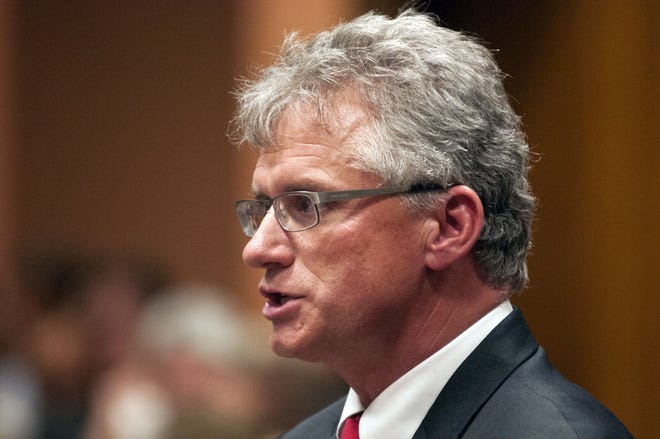
WORCESTER — Leominster-based Fidelity Bank and its former President John F. Merrill agreed to pay $22.5 million Friday to settle claims against them in a class-action lawsuit over the multibillion-dollar TelexFree Ponzi scheme.
The bank allowed TelexFree — one of the owners of whom is Merrill’s brother — to deposit large sums of money in bank accounts shortly before the scheme unraveled, though Merrill and the bank have not been criminally charged.
A lawyer for Fidelity, Ian D. Roffman, said Friday the bank and Merrill continue to deny any prior knowledge that TelexFree was a scam, and are confident they might have walked away paying nothing had they chosen not to settle.
However, Roffman said, there are never any guarantees in litigation, and a number of factors including hardships posed by the COVID-19 pandemic — influenced the decision.
“Removing the risk in litigation will be extremely meaningful,” Roffman said, as the bank “looks to weather the current economic storm … and come out even stronger.”
A lawyer for the plaintiffs, Robert J. Bonsignore, told a judge Friday that Fidelity “dealt with the situation not as fast as they should have,” but noted their services to TelexFree were of much shorter duration than other banks being sued.
“Fidelity was in and out of this in a second,” Bonsignore said, though he added the several months they provided services were important in keeping the company afloat.
“The fact they were only in it for a short time is still bad,” he said.
Friday’s settlement is only the second in what is anticipated to be a lengthy class-action lawsuit over TelexFree, a Marlboro-based company that disguised itself as an internet phone service company, but was in reality a giant pyramid scheme.
The company relied almost entirely on new infusions of cash from “promoters” — people who paid for the right to promote the voice-over internet services TelexFree provided — to stay afloat.
The promoters didn’t actually sell the product — only hyped it — and the scheme grew into a billion-dollar international operation now considered to have impacted more victims than any other Ponzi scheme in history.

“This litigation will quickly become very active and very expensive,” Roffman said Friday as he detailed Fidelity’s rationale for settling.
Fidelity’s involvement in the case stems from its decision to allow TelexFree to open several bank accounts for several months in late 2013.
Lawyers said Friday that former bank President John Merrill introduced his brother James M. Merrill — who co-owned TelexFree — to employees of the bank who set up the accounts.
James Merrill was sentenced to six years in federal prison in 2017 for his role in the scheme. John Merrill and Fidelity have denied prior knowledge TelexFree was a scheme, with Roffman Friday noting neither the bank nor the former president have been criminally charged.
Roffman Friday said John Merrill is a lifelong Worcester resident involved in many community and philanthropic organizations. He left the bank voluntarily in 2016, Roffman said.
John Merrill brought concerns about the volume of money flowing through TelexFree accounts to an outside auditor in 2013 who did not see anything “specifically suspicious” but recommended the accounts be closed because the company didn’t have the capacity to appropriately monitor such transactions, Roffman said
Fidelity allowed TelexFree to empty its accounts after deciding to suspend their relationship. The last accounts were closed in January of 2014, Roffman said, three months before authorities announced charges against TelexFree.
Roffman said Friday that the first time the bank or John Merrill heard of the charges was in the media. He said an outside investigation the bank ordered cleared Merrill and the bank of insider knowledge.
Bonsignore, the plaintiff’s lawyer, said Friday that John Merrill and Fidelity, as part of the settlement, agreed to share information with the plaintiffs to assist them in the case against other defendants.
Bonsignore said the plaintiffs have already questioned John Merrill.
“I’ll just leave it (there),” he said, before changing the subject.
It was not clear from Friday’s court hearing whether Merrill will be paying into the settlement. Bonsignore said Fidelity will be partly covered by insurance, but will also be paying a “considerable amount” out of pocket.
Bonsignore and Roffman both said the $22.5 million figure was a fair one achieved after help from experienced mediators, including firms that helped during litigation tied to the infamous Bernie Madoff Ponzi scheme.
Bonsignore said there are about 700,000 potential class members who have been contacted, with nobody lodging any valid objections to the settlement.
Bonsignore and the team of plaintiffs lawyers will receive 30% of the settlement — $6.75 million — in exchange for their work. Bonsignore said the rate is standard for cases of this nature.
The lawyer expounded at length upon the millions of pages of documents and many long-hour days lawyers have spent on the litigation, prompting U.S. District Court Judge Timothy S. Hillman to ask him to wrap up his summary early.
Hillman told both sides he would take the matter under advisement. Shortly thereafter, he filed decisions approving both the settlement and the lawyers’ requests for fees.
Lawyers did not state in court Friday how much the average person duped in the scheme might receive as a result of Fidelity’s settlement.
A website the plaintiffs have set up for victims, telexfreesettlement.com, indicates money won’t be paid out until later in the litigation.
Bonsignore said Friday he and his team of lawyers are in aggressive settlement talks with other defendants to get as much back for victims as possible.
The class-action case Fidelity settled Friday is separate from an ongoing action in U.S. Bankruptcy Court that is also returning money to victims.
Authorities last summer announced that $150 million in payments would be distributed to more than 100,000 victims in that case.
